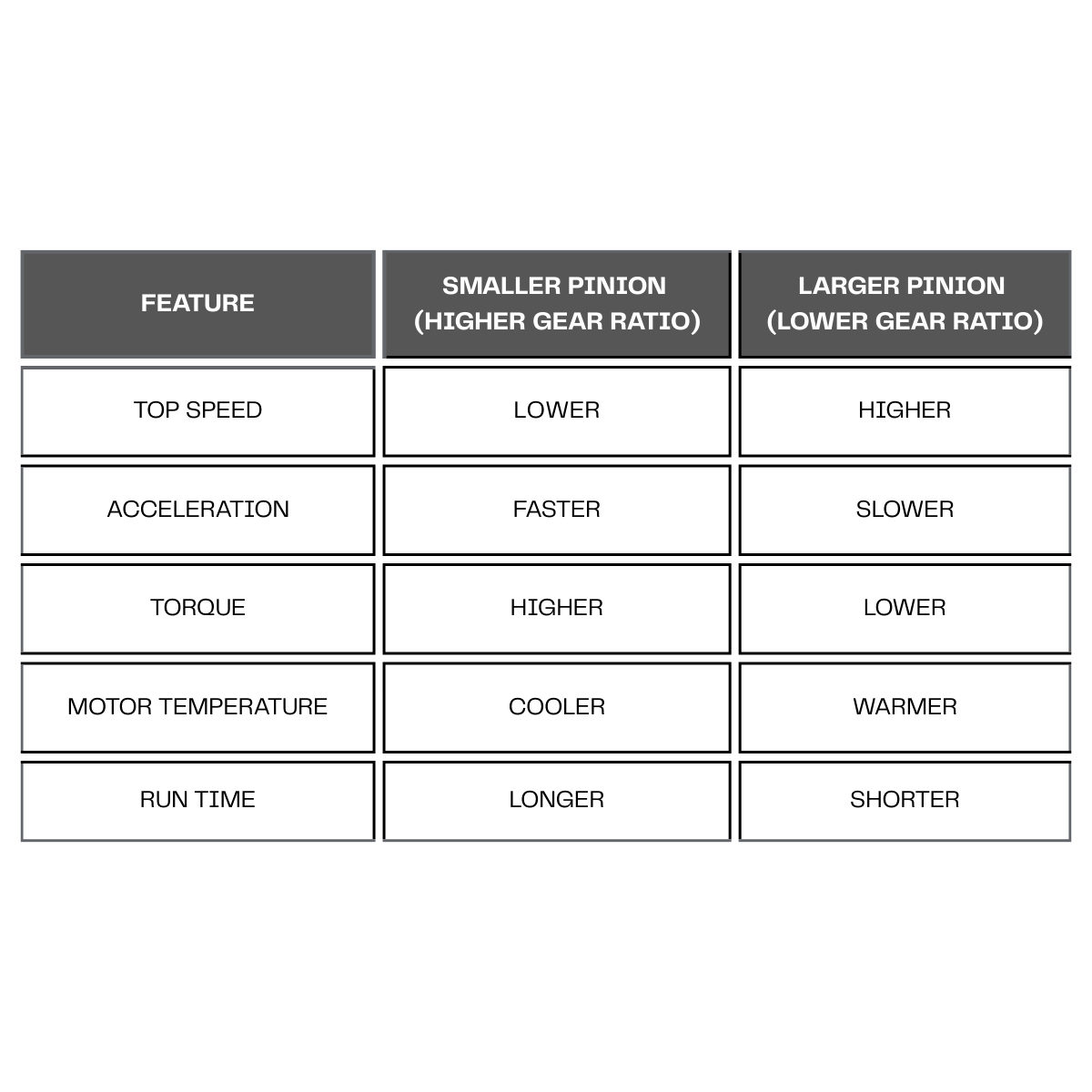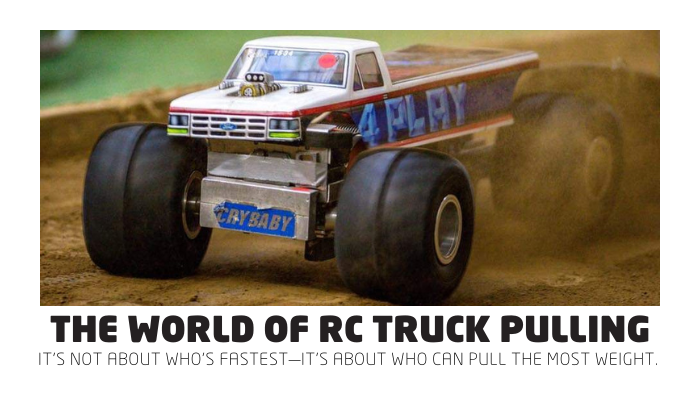Maximize RC Speed Without Overheating: Gearing Tips
Adjusting the gearing in your RC vehicle will likely be necessary if you want to optimize for different driving conditions, after upgrading electronics in an RC car, when experiencing issues like overheating or reduced performance or you simply changed to larger tires on your vehicle.
Since gearing is usually calculated for a specific motor (especially in an RTR) for a good combination of speed and torque, if you put a faster motor in your rig and don’t change the gearing to match, you could overheat your motor and/or ESC, resulting in a failure. Today we will dive into how to fine-tune your gearing for speed (mostly) without cooking your ESC or motor—and how a few Castle “tools” make it easy to get it right.
Gearing 101: The Balance of Speed and Heat
RC gearing comes down to two main components:
Pinion gear (on the motor): More teeth = more speed, less torque
Spur gear (on the drivetrain): Fewer teeth = more speed, less torque
This gives us a gear ratio:
Gear Ratio = Spur Teeth ÷ Pinion Teeth
Lower gear ratio = higher speed, but it also means your motor works harder—which increases heat.
How Far Can You Go Before It Gets Hot?
Damage and Failure: Excessive heat can degrade the insulation on motor windings and damage components within the ESC, potentially leading to complete failure.
Reduced Lifespan: Overheating can shorten the lifespan of both the ESC and the motor, requiring earlier replacement.
Reduced Efficiency: Overheated motors and ESCs may not be able to deliver the maximum power and efficiency, leading to slower speeds and reduced performance.
Increased Strain on Other Components: Overheating can put extra strain on other components, like the battery, which can also lead to damage or reduced lifespan
Safety Risks: In extreme cases, overheating can cause shorts or fires, posing a safety hazard.
Reduced Run Time: Overheating can also lead to reduced run time on a single battery charge as the components are less efficient.
YOU WANT YOUR ESC/MOTOR (AND BATTERIES) TO STAY BELOW 200°F / 93°C - THIS WILL SIGNIFICANTLY PROLONG THEIR LIFESPAN.
How to Formulate Gearing Adjustments
WE RECOMMEND THIS approach to find your max gearing:
Start with stock gearing.
Increase pinion by 1 tooth OR decrease spur by 2–4 teeth.
Test it running how you normally run for 5 minutes - Check temps every 60-90 seconds.
If temps are within range, and you want more, speed, change gearing and repeat.
Myth-Busting: Gearing Misconceptions
RC car gearing is a complex interplay of factors, and understanding these misconceptions is crucial for tuning your car for optimal performance. The right combination of motor Kv, voltage, gearing, and load will allow you to maximize your car's potential.
Gear pitch affects gear ratios.
The gear pitch has no impact on speed, heat, or stress on the electronics, the spur and pinion just need to be the same pitch. Ex: A 48-pitch, 20T Pinion with 80T Spur will run exactly the same as a 32-pitch setup with a 15T pinion with 60T spur. All that matters is the teeth ratio.
Lower Kv = More Torque
While a lower Kv motor does produce more torque at lower RPMs, it's not a blanket statement that it produces more torque overall compared to a higher Kv motor. The higher Kv motor can reach higher RPMs, potentially offering a higher total power output.
Increasing voltage lowers current draw because of Ohm’s Law
Increasing the voltage of a motor without adjusting the load or gearing will increase current, which can damage the motor, ESC, and battery. Motors are rated in Watts, so increasing the voltage, with no other changes, will increase the speed and in turn the current/wattage draw.
comparing higher versus lower gear ratio in an rc car
The Castle Toolbox
Not sure where to start with gearing or which Castle combo fits your rig? We’ve got you. The Castle Surface Product Selector helps you find the right ESC and motor for your vehicle and takes all of the guesswork out.
MULTIPLE COMBINATIONS: WE DON'T BELIEVE IN ONE-SIZE-FITS-ALL SOLUTIONS. THAT'S WHY WE OFFER 2-3 METICULOUSLY CRAFTED COMBINATIONS FOR EACH OF THE 150+ R/C VEHICLES FEATURED ON THIS PAGE.
GEARING RECOMMENDATIONS: WE DON'T STOP AT PROVIDING YOU WITH JUST POWER SYSTEMS, YOU’LL SEE HANDPICKED GEARING RECOMMENDATIONS TO HELP YOU ACHIEVE THE BEST PERFORMANCE POSSIBLE.
TOP SPEED UNLEASHED: WANT TO KNOW JUST HOW FAST YOU CAN GO? WE'LL GIVE YOU THE LOWDOWN ON THE TOP SPEED YOU CAN EXPECT WITH EACH RECOMMENDED CASTLE SYSTEM.
For over 25 years, Castle engineers have led the way in software innovation. With Castle Link, you can use your Windows™ PC, Apple iPhone™, or android phone to easily program your controller.
Within the Castle Link Toolbox there are a couple of programming TOOLS we recommend for gearing optimization:
Motor Temperature Cutoff (sensored motors only): When this setting is enabled, the controller will shut off if the motor reaches the specified temperature as indicated by its internal temperature sensor.
Data Logging - A number of Castle ESCs have Data Logging capabilities which captures and records performance data from your vehicle. This allows you to view a detailed turn-by-turn record of what your ESC actually experienced during the run. You will be able to record real-time data such as ESC and motor temperature, motor RPM, battery current and voltage, throttle input, and more.
A screenshot from castle link programming suite for motor temp cutoff.
a screenshot from castle link containing a data log. the temperature RECORDING is reflected in bold pink.
Bonus Tip: Cool It Down to Gear It Up
if you are hitting the thermal ceiling too early:
Add a motor heatsink or fan
Improve gearing margin with a lower-KV motor and taller gearing
Increase air flow to the ESC by opening up the body or cowling.
Final Thoughts: Speed with Smarts
Dialing in your gearing is part science, part art. With careful changes, good data, and the right Castle gear, you’ll find the sweet spot between savage speed and system safety.
So grab your temp gun, check your data logs, and if you’re not sure where to start—try the Surface Product Selector.
Your Castle-powered ride deserves it!
If there’s a topic you’d love to see us cover in a future blog, let us know in the comments—we’re always looking for fresh ideas and insights from our community.
🙌 Thanks for reading, and we’ll catch you in the next one!








